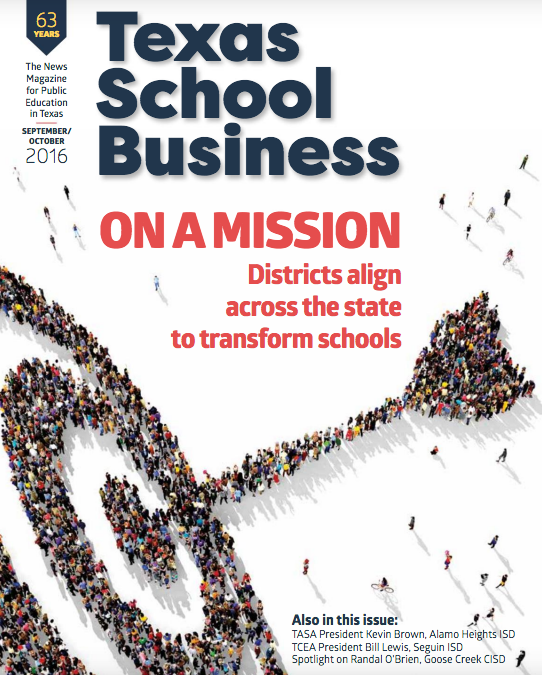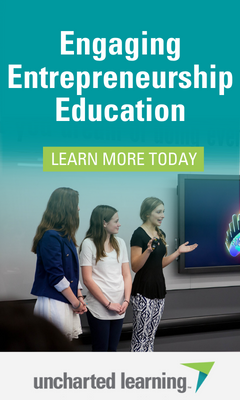The Mission: School Transformation movement is spreading like wildfire across Texas, clearing out old ways of doing things and making room for new growth.
Their ideas, published in the document, Creating a New Vision for Public Education in Texas, called for engagement in digital learning, multiple assessments for students, meaningful learning standards, organizational transformation, and a restoration of local control.
A fantastic vision, indeed. But who would bring it into existence? Enter the Texas High Performance Schools Consortium, 23 districts selected in 2012 by the Texas education commissioner and charged with turning the vision into a reality.
In recent years, the Texas High Performance Schools Consortium has grown to include about 85 associate districts, all desiring to support Mission: School Transformation and bring the new vision for Texas public education to life.
In tandem, more centralized efforts have gained momentum too. Brandon H. Core, TASA’s associate executive director of school transformation and leadership services, says his department has created professional development offerings and opportunities to connect and collaborate. Moreover, in March, TASA launched a website for Mission: School Transformation, providing an online archive of related content and information on how to get involved.
There has been an organic wellspring of regional groups determined to see the new vision take root — outfits like the North Texas Regional Consortium (NTRC) and the Community Schools Transformation Alliance (CSTA). Allen, Coppell, Frisco, Highland Park, Lewisville, McKinney, Northwest, Plano, and Richardson make up the NTRC. CSTA is comprised of Anna, Blue Ridge, Caddo Mills, Celeste, Commerce, Community, Crandall, Farmersville, Kemp, Melissa, Royse City, Sunnyvale, Van Alstyne, and Wolfe City.
Sunnyvale ISD Superintendent Doug Williams says: “We have to change education one classroom at a time. As superintendents, we can discuss how it should change, but true change happens with the classroom teacher.”
Williams says CSTA has “moved away” from superintendent-led discussions on big-picture ideas. Instead, the alliance has embraced a more teacher-centric approach, providing space for educators to share their ideas. He points to EdCamp as one example. The content of this CSTA event is driven by what teachers and campus administrators want to explore and learn.
“The regionals are having a great impact,” she says. “In our consortium work, the main focus has been how we can learn from each other.”
She points to transformation site visits as a key example. For these visits, small groups of teachers and administrators travel to other schools within the NTRC to observe their peers in action. At the end of the day, the visiting teachers have a chance to compare notes.
“They share resources and knowledge and go back to their districts to work with principals and campuses,” says Gardiner. “The idea is to let it serve as a laboratory.”
Gardiner says teachers participating in site visits have been eager to learn how others integrate technology, improve STEAM and STEM education and incorporate multiple ways to assess students.
Looking ahead, NTRC also sought proposals from area universities to develop curriculum that supports the new vision. The North Texas group found a partner in Dallas Baptist University (DBU).
“DBU feels really privileged,” Dugger says. “We really want to develop servant leaders to make a difference.”
Ultimately, of course, making a difference comes down to what happens in the classroom. TASA President and Alamo Heights ISD Superintendent Kevin Brown, whose district is a Texas High Performance Schools Consortium associate member, says student engagement has been the focus of school transformation efforts in Alamo Heights.
“If I walk into a classroom, rather than seeing kids sitting in rows listening to the teacher, I want to see them doing something, whether working in teams on a project or preparing a presentation,” he says.
As one example, Brown cited a high school rocketry course. The course is not about encouraging all students to become rocket scientists, but to show students that what they learn in school has real-world application.
Alamo Heights ISD also launched a pilot program this year in 17 redesigned classrooms, where every student is given a digital device. The district provided an intensive, one-week training for the pilot teachers, who will continue to receive support from instructional coaches. The goal is to expand the program district-wide within the next three years.
“Let’s move the needle slowly,” says Brown. “I would rather have lots of small successes than a big failure. It’s not about the technology. It’s about designing experiences for kids that result in profound learning.”
The focus for some districts, like Clear Creek ISD, has been developing meaningful assessments, based on their communities’ values.
“We’re no longer focused on assessments for accountability,” says Superintendent Greg Smith, a member of the Visioning Institute and the High Performance Schools Consortium steering committee. “It’s about using multiple assessments to diagnose students and teach to their needs.”
He says the district is more interested in what students are doing in their classrooms, as well as on the PSAT, SAT and TSIA — rather than the STAAR test. Other measures may include how students perform in robotics or in science fair projects, for example. Smith says the system has been in use for the past three years.
Hudson Superintendent Mary Ann Whiteker serves on the steering committee for associate members of the Texas High Performance Schools Consortium. She was downright gleeful as she recalled the day she took down the informational banners about state testing in her school district.
“I sent an administrative directive that no teacher could mention the tests and no worksheets could go home,” Whiteker says. “Five years ago, our district embraced the new vision 100 percent.”
She says her district uses multiple forms of assessments, such as portfolios, in which teachers maintain folders on the work that students produce, and authentic assessments, such as asking students to do presentations on what they have learned. Another key difference is having frequent assessments in all grades on what teachers taught. Teachers are encouraged to do quizzes at nine-week intervals to review material. These quizzes typically contain 30 short questions and a few essay questions. In high school, teachers also administer end-of-semester exams.
Whiteker adds: “We redesigned the campus to align with the 21st century learning plans. It was a yearlong process, analyzing the principles and figuring out where we were and what the barriers were to what we needed to do.”
A campus redesign doesn’t necessarily mean knocking out walls. It’s more about rethinking how teachers and students operate within a space. Furniture has been rearranged to promote group participation and collaboration, she says.
According to Whiteker, the visioning document has “changed the culture of schools and community. It brings the joy of teaching and learning back to the classroom.”
There are, of course, speed bumps on the path to re-visioning public education in Texas, especially in more rural districts.
“It’s still challenging with STEM,” admits Kim Alexander, superintendent of Roscoe Collegiate ISD, one of the original 23 districts in the Texas High Performance Schools Consortium.
Yet, his district is making strides on other fronts. Alexander has devoted resources to the state’s first early college program in a rural district. Launched in 2009, the program’s courses start in ninth grade, but visionary thinking is part of the district’s culture from early childhood classes onward.
Early college is designed to “break generational poverty,” explains Alexander. The expectation is that all students will take college courses, and 90 percent or more will complete an associate degree prior to graduation from high school. In addition, all students in grades 7 through 12 go through the AVID College Readiness Curriculum every day.
“We develop partnerships with real for-profit businesses that pay student apprentices,” Alexander says.
These opportunities include hands-on experience in a range of fields, from biomedical science to engineering. Students can earn certifications too, from veterinary assistant to embryologist.
Visionary work is possible even in the smallest of districts. Case in point: Gunter ISD, student population 798.
In partnership with neighboring Van Alstyne ISD, Superintendent Jill Siler’s district is finding new ways to support teachers as they align student instruction with the new vision. She says Gunter ISD also is exploring options for assessments that “don’t look like STAAR.” While a few traditional assessments remain, some innovative approaches include student projects that demonstrate skill mastery. For instance, Gunter ISD students have built and tested miniature roller-coasters to demonstrate their understanding of kinetic and potential energy.
Siler admits she can’t make advancements on all fronts. The district’s size and financial constraints mean “technology is nowhere near where we want it to be.”
“We’re just building the infrastructure to go to a 1:1, but we won’t let that be a barrier. We want to have intentional conversations about what we want the educational environment to look like,” she says.
Creating more opportunities for conversations at the campus, district, regional, and state level are key to the advancement of school transformation.
Says Core: “Through partnerships, we are advancing the work and changing the things we can control.”

